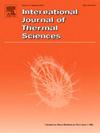Research on enhancing impingement structure heat transfer capability based on secondary impingement
IF 4.9
2区 工程技术
Q1 ENGINEERING, MECHANICAL
International Journal of Thermal Sciences
Pub Date : 2025-01-09
DOI:10.1016/j.ijthermalsci.2025.109695
引用次数: 0
Abstract
Impingement structure, renowned for its compact design and exceptional heat transfer capabilities, finds widespread application in diverse cooling systems. The presence of ribs and the prevailing crossflow conditions exert a significant influence on the flow and heat transfer characteristics of the impingement. This study employs the turbulence model to numerically investigate the performance of a single-nozzle impingement with a ribbed target. Experimental validation, conducted using the steady-state copper block method, ensures the accuracy of the numerical simulations. By delving into the secondary impact phenomenon induced by the ribs, a step rib configuration is proposed to enhance heat transfer. The optimal rib arrangement under varying crossflow conditions is also explored. The findings reveal that step ribs can effectively elevate the and the by 7.67 % and 25.47 %, compared to a smooth target. This improvement underscores that the enhancement in heat transfer performance is not solely attributed to an increased heat transfer area but also benefits from favorable aerodynamic effects. The optimal rib placement varies with different crossflow conditions. Under low crossflow conditions, the most advantageous rib positioning coincides with the region influenced by the crossflow stagnation point. Conversely, at high crossflow conditions, the optimal rib placement is upstream of the impingement jet.
求助全文
约1分钟内获得全文
求助全文
来源期刊

International Journal of Thermal Sciences
工程技术-工程:机械
CiteScore
8.10
自引率
11.10%
发文量
531
审稿时长
55 days
期刊介绍:
The International Journal of Thermal Sciences is a journal devoted to the publication of fundamental studies on the physics of transfer processes in general, with an emphasis on thermal aspects and also applied research on various processes, energy systems and the environment. Articles are published in English and French, and are subject to peer review.
The fundamental subjects considered within the scope of the journal are:
* Heat and relevant mass transfer at all scales (nano, micro and macro) and in all types of material (heterogeneous, composites, biological,...) and fluid flow
* Forced, natural or mixed convection in reactive or non-reactive media
* Single or multi–phase fluid flow with or without phase change
* Near–and far–field radiative heat transfer
* Combined modes of heat transfer in complex systems (for example, plasmas, biological, geological,...)
* Multiscale modelling
The applied research topics include:
* Heat exchangers, heat pipes, cooling processes
* Transport phenomena taking place in industrial processes (chemical, food and agricultural, metallurgical, space and aeronautical, automobile industries)
* Nano–and micro–technology for energy, space, biosystems and devices
* Heat transport analysis in advanced systems
* Impact of energy–related processes on environment, and emerging energy systems
The study of thermophysical properties of materials and fluids, thermal measurement techniques, inverse methods, and the developments of experimental methods are within the scope of the International Journal of Thermal Sciences which also covers the modelling, and numerical methods applied to thermal transfer.
 求助内容:
求助内容: 应助结果提醒方式:
应助结果提醒方式:


